Regulatory Environment Impact on British American Tobacco
VerifiedAdded on 2023/01/19
|12
|2976
|89
AI Summary
The report analyzes the regulatory environment that affects the operational performance of British American Tobacco and its impact on products and services.
Contribute Materials
Your contribution can guide someone’s learning journey. Share your
documents today.

Running head: ACCOUNTING
Accounting
Name of the Student
Name of the University
Authors Note
Course ID
Accounting
Name of the Student
Name of the University
Authors Note
Course ID
Secure Best Marks with AI Grader
Need help grading? Try our AI Grader for instant feedback on your assignments.
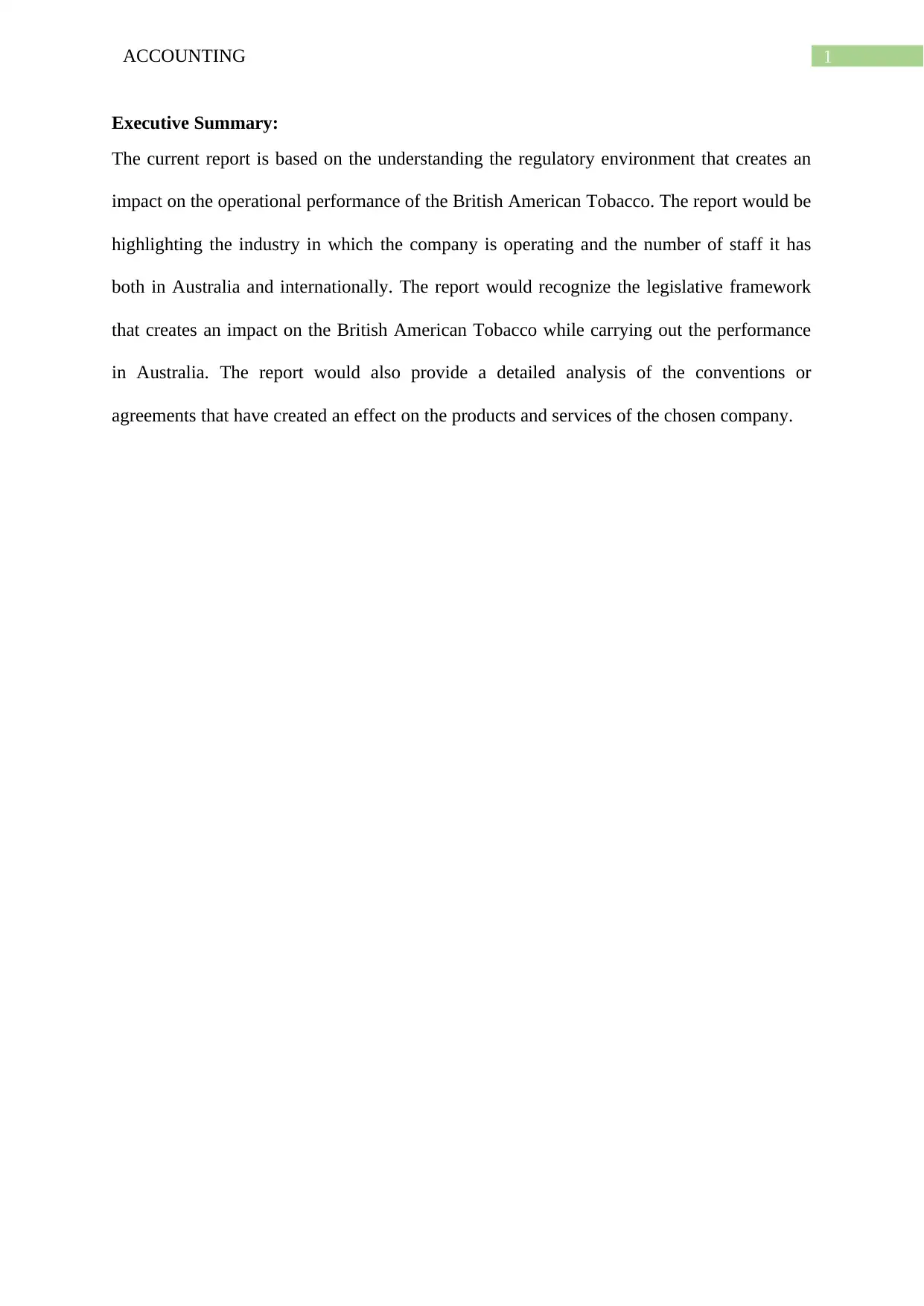
1ACCOUNTING
Executive Summary:
The current report is based on the understanding the regulatory environment that creates an
impact on the operational performance of the British American Tobacco. The report would be
highlighting the industry in which the company is operating and the number of staff it has
both in Australia and internationally. The report would recognize the legislative framework
that creates an impact on the British American Tobacco while carrying out the performance
in Australia. The report would also provide a detailed analysis of the conventions or
agreements that have created an effect on the products and services of the chosen company.
Executive Summary:
The current report is based on the understanding the regulatory environment that creates an
impact on the operational performance of the British American Tobacco. The report would be
highlighting the industry in which the company is operating and the number of staff it has
both in Australia and internationally. The report would recognize the legislative framework
that creates an impact on the British American Tobacco while carrying out the performance
in Australia. The report would also provide a detailed analysis of the conventions or
agreements that have created an effect on the products and services of the chosen company.
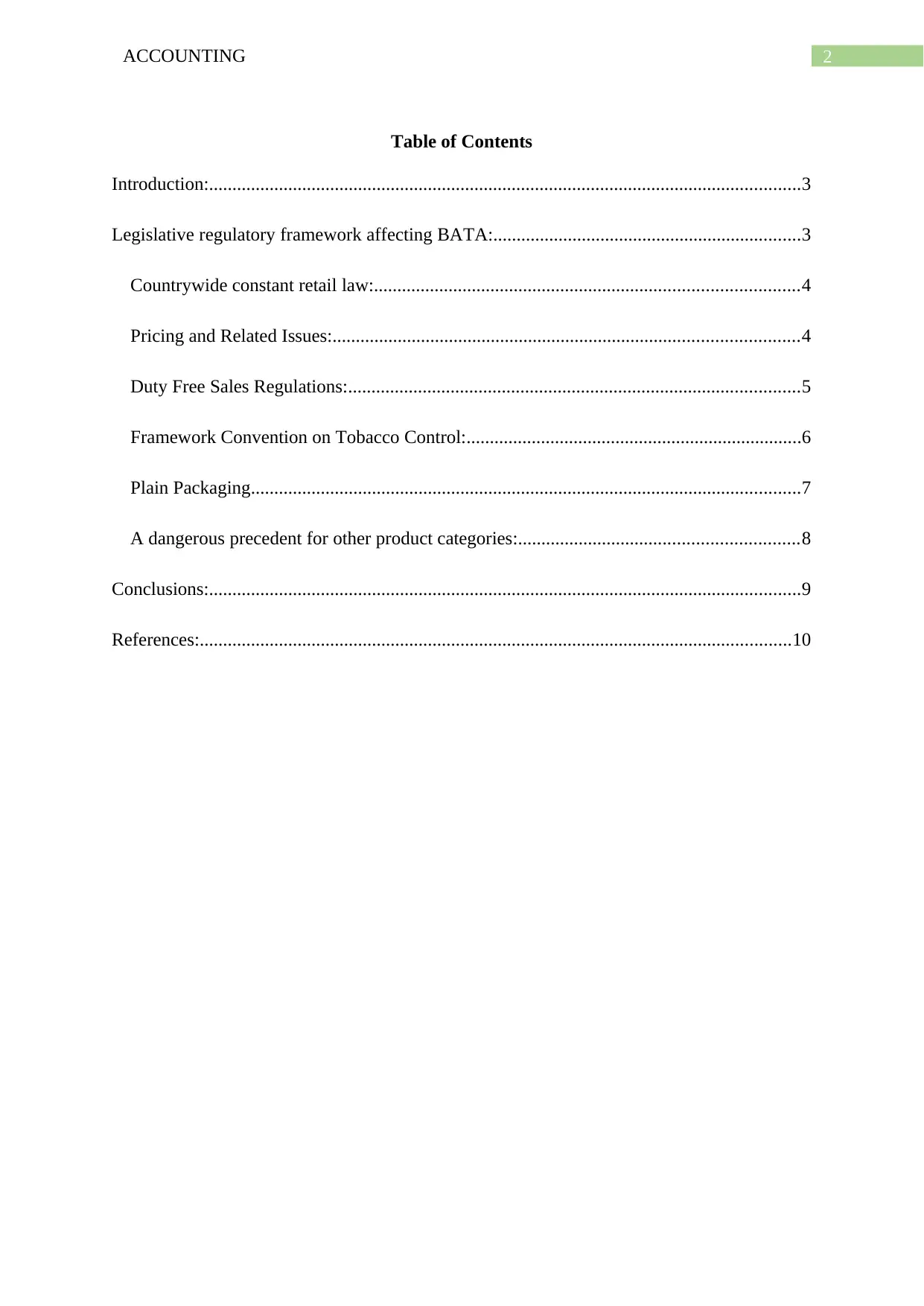
2ACCOUNTING
Table of Contents
Introduction:...............................................................................................................................3
Legislative regulatory framework affecting BATA:..................................................................3
Countrywide constant retail law:...........................................................................................4
Pricing and Related Issues:....................................................................................................4
Duty Free Sales Regulations:.................................................................................................5
Framework Convention on Tobacco Control:........................................................................6
Plain Packaging......................................................................................................................7
A dangerous precedent for other product categories:............................................................8
Conclusions:...............................................................................................................................9
References:...............................................................................................................................10
Table of Contents
Introduction:...............................................................................................................................3
Legislative regulatory framework affecting BATA:..................................................................3
Countrywide constant retail law:...........................................................................................4
Pricing and Related Issues:....................................................................................................4
Duty Free Sales Regulations:.................................................................................................5
Framework Convention on Tobacco Control:........................................................................6
Plain Packaging......................................................................................................................7
A dangerous precedent for other product categories:............................................................8
Conclusions:...............................................................................................................................9
References:...............................................................................................................................10
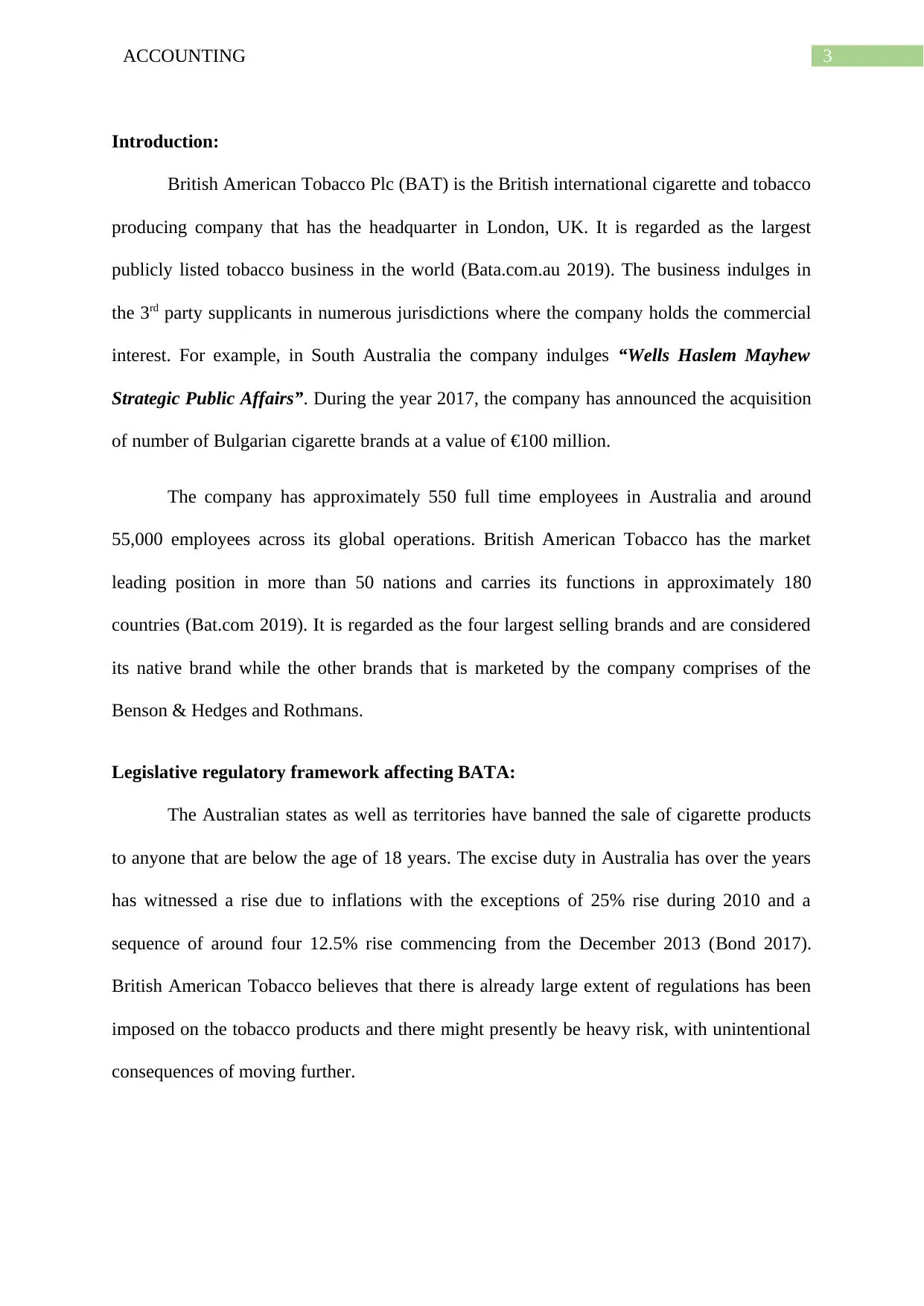
3ACCOUNTING
Introduction:
British American Tobacco Plc (BAT) is the British international cigarette and tobacco
producing company that has the headquarter in London, UK. It is regarded as the largest
publicly listed tobacco business in the world (Bata.com.au 2019). The business indulges in
the 3rd party supplicants in numerous jurisdictions where the company holds the commercial
interest. For example, in South Australia the company indulges “Wells Haslem Mayhew
Strategic Public Affairs”. During the year 2017, the company has announced the acquisition
of number of Bulgarian cigarette brands at a value of €100 million.
The company has approximately 550 full time employees in Australia and around
55,000 employees across its global operations. British American Tobacco has the market
leading position in more than 50 nations and carries its functions in approximately 180
countries (Bat.com 2019). It is regarded as the four largest selling brands and are considered
its native brand while the other brands that is marketed by the company comprises of the
Benson & Hedges and Rothmans.
Legislative regulatory framework affecting BATA:
The Australian states as well as territories have banned the sale of cigarette products
to anyone that are below the age of 18 years. The excise duty in Australia has over the years
has witnessed a rise due to inflations with the exceptions of 25% rise during 2010 and a
sequence of around four 12.5% rise commencing from the December 2013 (Bond 2017).
British American Tobacco believes that there is already large extent of regulations has been
imposed on the tobacco products and there might presently be heavy risk, with unintentional
consequences of moving further.
Introduction:
British American Tobacco Plc (BAT) is the British international cigarette and tobacco
producing company that has the headquarter in London, UK. It is regarded as the largest
publicly listed tobacco business in the world (Bata.com.au 2019). The business indulges in
the 3rd party supplicants in numerous jurisdictions where the company holds the commercial
interest. For example, in South Australia the company indulges “Wells Haslem Mayhew
Strategic Public Affairs”. During the year 2017, the company has announced the acquisition
of number of Bulgarian cigarette brands at a value of €100 million.
The company has approximately 550 full time employees in Australia and around
55,000 employees across its global operations. British American Tobacco has the market
leading position in more than 50 nations and carries its functions in approximately 180
countries (Bat.com 2019). It is regarded as the four largest selling brands and are considered
its native brand while the other brands that is marketed by the company comprises of the
Benson & Hedges and Rothmans.
Legislative regulatory framework affecting BATA:
The Australian states as well as territories have banned the sale of cigarette products
to anyone that are below the age of 18 years. The excise duty in Australia has over the years
has witnessed a rise due to inflations with the exceptions of 25% rise during 2010 and a
sequence of around four 12.5% rise commencing from the December 2013 (Bond 2017).
British American Tobacco believes that there is already large extent of regulations has been
imposed on the tobacco products and there might presently be heavy risk, with unintentional
consequences of moving further.
Secure Best Marks with AI Grader
Need help grading? Try our AI Grader for instant feedback on your assignments.
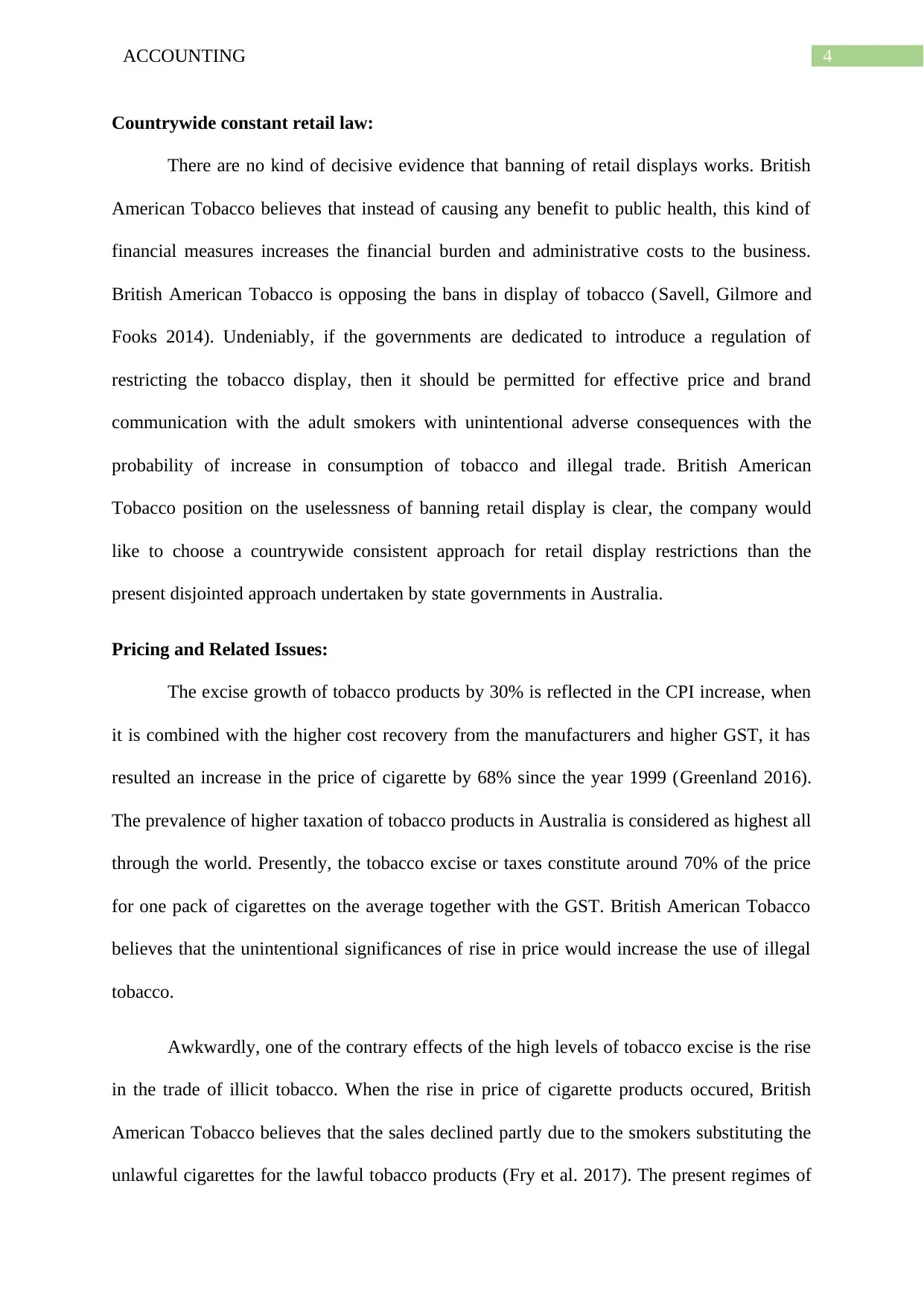
4ACCOUNTING
Countrywide constant retail law:
There are no kind of decisive evidence that banning of retail displays works. British
American Tobacco believes that instead of causing any benefit to public health, this kind of
financial measures increases the financial burden and administrative costs to the business.
British American Tobacco is opposing the bans in display of tobacco (Savell, Gilmore and
Fooks 2014). Undeniably, if the governments are dedicated to introduce a regulation of
restricting the tobacco display, then it should be permitted for effective price and brand
communication with the adult smokers with unintentional adverse consequences with the
probability of increase in consumption of tobacco and illegal trade. British American
Tobacco position on the uselessness of banning retail display is clear, the company would
like to choose a countrywide consistent approach for retail display restrictions than the
present disjointed approach undertaken by state governments in Australia.
Pricing and Related Issues:
The excise growth of tobacco products by 30% is reflected in the CPI increase, when
it is combined with the higher cost recovery from the manufacturers and higher GST, it has
resulted an increase in the price of cigarette by 68% since the year 1999 (Greenland 2016).
The prevalence of higher taxation of tobacco products in Australia is considered as highest all
through the world. Presently, the tobacco excise or taxes constitute around 70% of the price
for one pack of cigarettes on the average together with the GST. British American Tobacco
believes that the unintentional significances of rise in price would increase the use of illegal
tobacco.
Awkwardly, one of the contrary effects of the high levels of tobacco excise is the rise
in the trade of illicit tobacco. When the rise in price of cigarette products occured, British
American Tobacco believes that the sales declined partly due to the smokers substituting the
unlawful cigarettes for the lawful tobacco products (Fry et al. 2017). The present regimes of
Countrywide constant retail law:
There are no kind of decisive evidence that banning of retail displays works. British
American Tobacco believes that instead of causing any benefit to public health, this kind of
financial measures increases the financial burden and administrative costs to the business.
British American Tobacco is opposing the bans in display of tobacco (Savell, Gilmore and
Fooks 2014). Undeniably, if the governments are dedicated to introduce a regulation of
restricting the tobacco display, then it should be permitted for effective price and brand
communication with the adult smokers with unintentional adverse consequences with the
probability of increase in consumption of tobacco and illegal trade. British American
Tobacco position on the uselessness of banning retail display is clear, the company would
like to choose a countrywide consistent approach for retail display restrictions than the
present disjointed approach undertaken by state governments in Australia.
Pricing and Related Issues:
The excise growth of tobacco products by 30% is reflected in the CPI increase, when
it is combined with the higher cost recovery from the manufacturers and higher GST, it has
resulted an increase in the price of cigarette by 68% since the year 1999 (Greenland 2016).
The prevalence of higher taxation of tobacco products in Australia is considered as highest all
through the world. Presently, the tobacco excise or taxes constitute around 70% of the price
for one pack of cigarettes on the average together with the GST. British American Tobacco
believes that the unintentional significances of rise in price would increase the use of illegal
tobacco.
Awkwardly, one of the contrary effects of the high levels of tobacco excise is the rise
in the trade of illicit tobacco. When the rise in price of cigarette products occured, British
American Tobacco believes that the sales declined partly due to the smokers substituting the
unlawful cigarettes for the lawful tobacco products (Fry et al. 2017). The present regimes of
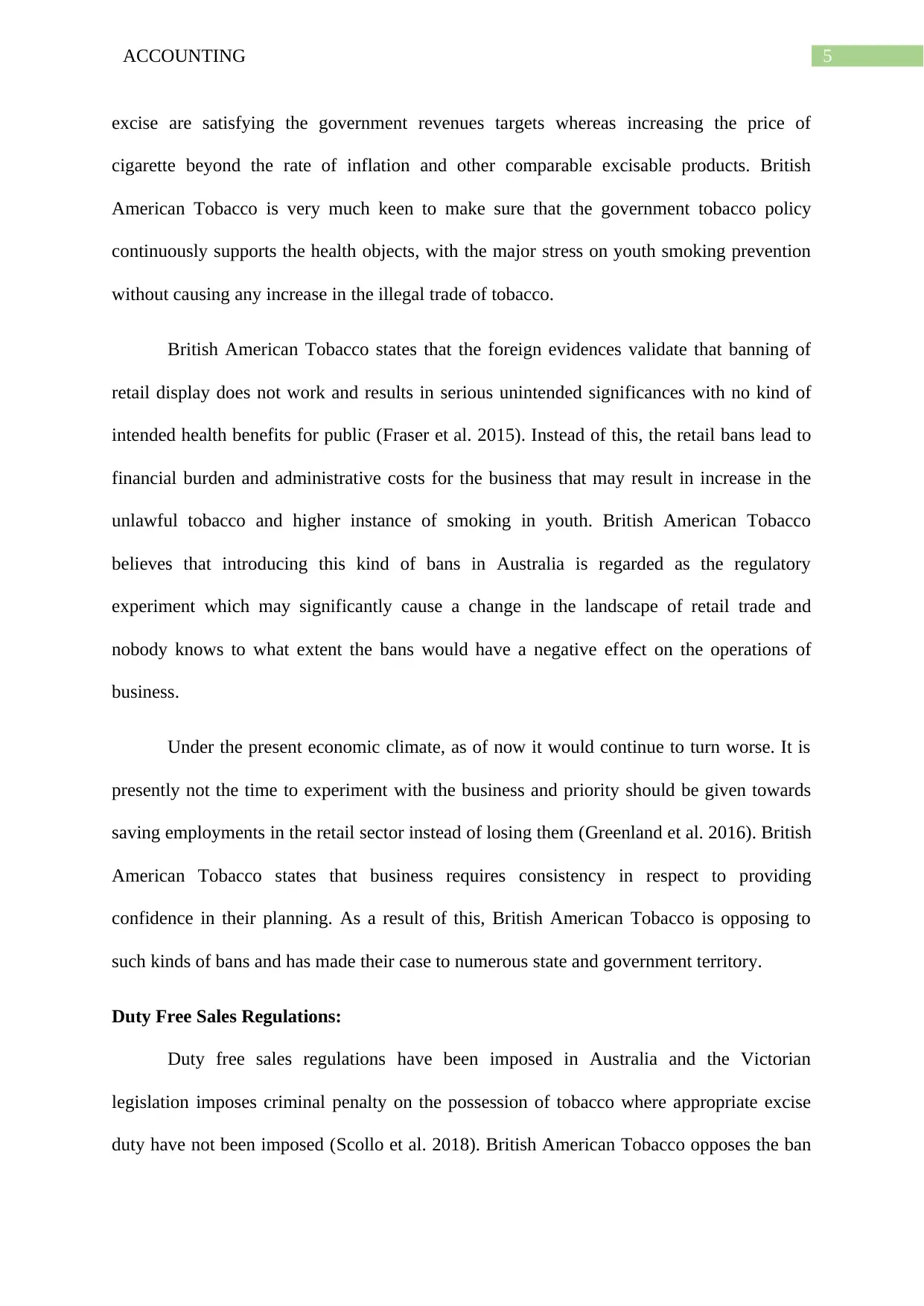
5ACCOUNTING
excise are satisfying the government revenues targets whereas increasing the price of
cigarette beyond the rate of inflation and other comparable excisable products. British
American Tobacco is very much keen to make sure that the government tobacco policy
continuously supports the health objects, with the major stress on youth smoking prevention
without causing any increase in the illegal trade of tobacco.
British American Tobacco states that the foreign evidences validate that banning of
retail display does not work and results in serious unintended significances with no kind of
intended health benefits for public (Fraser et al. 2015). Instead of this, the retail bans lead to
financial burden and administrative costs for the business that may result in increase in the
unlawful tobacco and higher instance of smoking in youth. British American Tobacco
believes that introducing this kind of bans in Australia is regarded as the regulatory
experiment which may significantly cause a change in the landscape of retail trade and
nobody knows to what extent the bans would have a negative effect on the operations of
business.
Under the present economic climate, as of now it would continue to turn worse. It is
presently not the time to experiment with the business and priority should be given towards
saving employments in the retail sector instead of losing them (Greenland et al. 2016). British
American Tobacco states that business requires consistency in respect to providing
confidence in their planning. As a result of this, British American Tobacco is opposing to
such kinds of bans and has made their case to numerous state and government territory.
Duty Free Sales Regulations:
Duty free sales regulations have been imposed in Australia and the Victorian
legislation imposes criminal penalty on the possession of tobacco where appropriate excise
duty have not been imposed (Scollo et al. 2018). British American Tobacco opposes the ban
excise are satisfying the government revenues targets whereas increasing the price of
cigarette beyond the rate of inflation and other comparable excisable products. British
American Tobacco is very much keen to make sure that the government tobacco policy
continuously supports the health objects, with the major stress on youth smoking prevention
without causing any increase in the illegal trade of tobacco.
British American Tobacco states that the foreign evidences validate that banning of
retail display does not work and results in serious unintended significances with no kind of
intended health benefits for public (Fraser et al. 2015). Instead of this, the retail bans lead to
financial burden and administrative costs for the business that may result in increase in the
unlawful tobacco and higher instance of smoking in youth. British American Tobacco
believes that introducing this kind of bans in Australia is regarded as the regulatory
experiment which may significantly cause a change in the landscape of retail trade and
nobody knows to what extent the bans would have a negative effect on the operations of
business.
Under the present economic climate, as of now it would continue to turn worse. It is
presently not the time to experiment with the business and priority should be given towards
saving employments in the retail sector instead of losing them (Greenland et al. 2016). British
American Tobacco states that business requires consistency in respect to providing
confidence in their planning. As a result of this, British American Tobacco is opposing to
such kinds of bans and has made their case to numerous state and government territory.
Duty Free Sales Regulations:
Duty free sales regulations have been imposed in Australia and the Victorian
legislation imposes criminal penalty on the possession of tobacco where appropriate excise
duty have not been imposed (Scollo et al. 2018). British American Tobacco opposes the ban

6ACCOUNTING
of duty free sale of tobacco products since the products are highly regulated and equals
around 1% of the total Australian industry. When compared to the other channels, there are
no overall benefits in removing the sales from either a health or illegal trade standpoint,
rather simply adding inconvenience to the international travelling public and negative effect
on Australian business. Such kinds of restrictions would have unintentional consequences on
the revenues and employment provided that the customers would simply purchase the
tobacco products from other jurisdictions instead of Australia (Farley et al. 2015). This would
create an effect on the Australian business instead of creating an effect on the rate of
smoking.
Treaties, Conventions or agreements that have effected on the product and services of
British American Tobacco:
Framework Convention on Tobacco Control:
Australia became the signatory to the world health organization framework
convention on the tobacco control during 5th December 2003. The conference of the parties
has undertaken a detailed guideline for efficient application of several wide range of
legislative, executive, administrative and other necessary measures that are needed under the
convention (Kmietowicz 2014). Altogether the FCTC and its guidelines possess the potential
of setting the priorities of the Australian government together with the commonwealth, state
and territory in respect of the tobacco control policies and programmes.
Nevertheless, there are several retailers that makes the use of internet to purchase the
cigarettes from the wholesalers. These sales can be regulated together with the relevant
tobacco excise that acts as the example of making sure that the legitimate small business can
continue to function efficiently by making use of the technology to their advantage (Sinclair
et al. 2014). British American Tobacco believes that the regulation across the business to the
of duty free sale of tobacco products since the products are highly regulated and equals
around 1% of the total Australian industry. When compared to the other channels, there are
no overall benefits in removing the sales from either a health or illegal trade standpoint,
rather simply adding inconvenience to the international travelling public and negative effect
on Australian business. Such kinds of restrictions would have unintentional consequences on
the revenues and employment provided that the customers would simply purchase the
tobacco products from other jurisdictions instead of Australia (Farley et al. 2015). This would
create an effect on the Australian business instead of creating an effect on the rate of
smoking.
Treaties, Conventions or agreements that have effected on the product and services of
British American Tobacco:
Framework Convention on Tobacco Control:
Australia became the signatory to the world health organization framework
convention on the tobacco control during 5th December 2003. The conference of the parties
has undertaken a detailed guideline for efficient application of several wide range of
legislative, executive, administrative and other necessary measures that are needed under the
convention (Kmietowicz 2014). Altogether the FCTC and its guidelines possess the potential
of setting the priorities of the Australian government together with the commonwealth, state
and territory in respect of the tobacco control policies and programmes.
Nevertheless, there are several retailers that makes the use of internet to purchase the
cigarettes from the wholesalers. These sales can be regulated together with the relevant
tobacco excise that acts as the example of making sure that the legitimate small business can
continue to function efficiently by making use of the technology to their advantage (Sinclair
et al. 2014). British American Tobacco believes that the regulation across the business to the
Paraphrase This Document
Need a fresh take? Get an instant paraphrase of this document with our AI Paraphraser
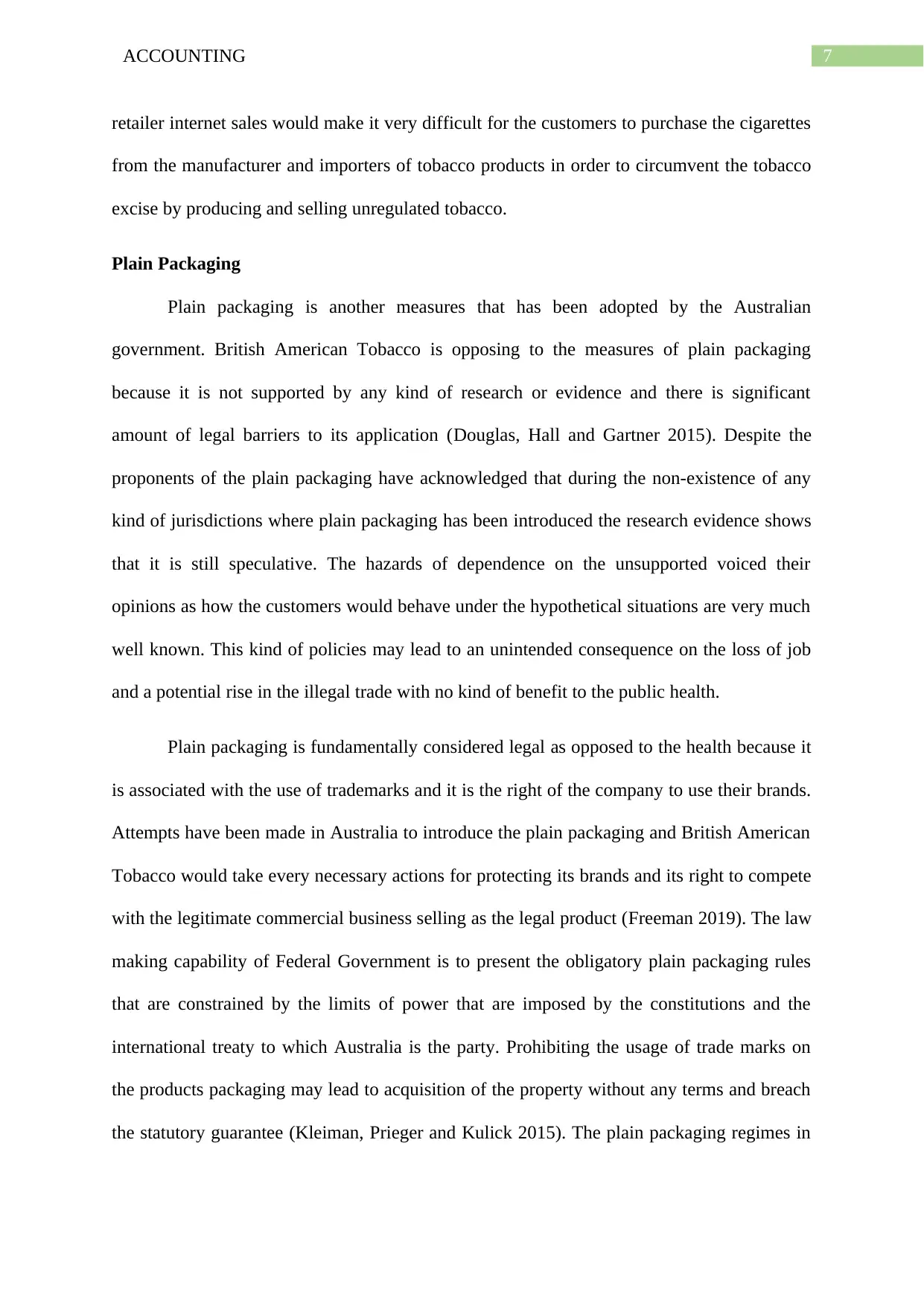
7ACCOUNTING
retailer internet sales would make it very difficult for the customers to purchase the cigarettes
from the manufacturer and importers of tobacco products in order to circumvent the tobacco
excise by producing and selling unregulated tobacco.
Plain Packaging
Plain packaging is another measures that has been adopted by the Australian
government. British American Tobacco is opposing to the measures of plain packaging
because it is not supported by any kind of research or evidence and there is significant
amount of legal barriers to its application (Douglas, Hall and Gartner 2015). Despite the
proponents of the plain packaging have acknowledged that during the non-existence of any
kind of jurisdictions where plain packaging has been introduced the research evidence shows
that it is still speculative. The hazards of dependence on the unsupported voiced their
opinions as how the customers would behave under the hypothetical situations are very much
well known. This kind of policies may lead to an unintended consequence on the loss of job
and a potential rise in the illegal trade with no kind of benefit to the public health.
Plain packaging is fundamentally considered legal as opposed to the health because it
is associated with the use of trademarks and it is the right of the company to use their brands.
Attempts have been made in Australia to introduce the plain packaging and British American
Tobacco would take every necessary actions for protecting its brands and its right to compete
with the legitimate commercial business selling as the legal product (Freeman 2019). The law
making capability of Federal Government is to present the obligatory plain packaging rules
that are constrained by the limits of power that are imposed by the constitutions and the
international treaty to which Australia is the party. Prohibiting the usage of trade marks on
the products packaging may lead to acquisition of the property without any terms and breach
the statutory guarantee (Kleiman, Prieger and Kulick 2015). The plain packaging regimes in
retailer internet sales would make it very difficult for the customers to purchase the cigarettes
from the manufacturer and importers of tobacco products in order to circumvent the tobacco
excise by producing and selling unregulated tobacco.
Plain Packaging
Plain packaging is another measures that has been adopted by the Australian
government. British American Tobacco is opposing to the measures of plain packaging
because it is not supported by any kind of research or evidence and there is significant
amount of legal barriers to its application (Douglas, Hall and Gartner 2015). Despite the
proponents of the plain packaging have acknowledged that during the non-existence of any
kind of jurisdictions where plain packaging has been introduced the research evidence shows
that it is still speculative. The hazards of dependence on the unsupported voiced their
opinions as how the customers would behave under the hypothetical situations are very much
well known. This kind of policies may lead to an unintended consequence on the loss of job
and a potential rise in the illegal trade with no kind of benefit to the public health.
Plain packaging is fundamentally considered legal as opposed to the health because it
is associated with the use of trademarks and it is the right of the company to use their brands.
Attempts have been made in Australia to introduce the plain packaging and British American
Tobacco would take every necessary actions for protecting its brands and its right to compete
with the legitimate commercial business selling as the legal product (Freeman 2019). The law
making capability of Federal Government is to present the obligatory plain packaging rules
that are constrained by the limits of power that are imposed by the constitutions and the
international treaty to which Australia is the party. Prohibiting the usage of trade marks on
the products packaging may lead to acquisition of the property without any terms and breach
the statutory guarantee (Kleiman, Prieger and Kulick 2015). The plain packaging regimes in
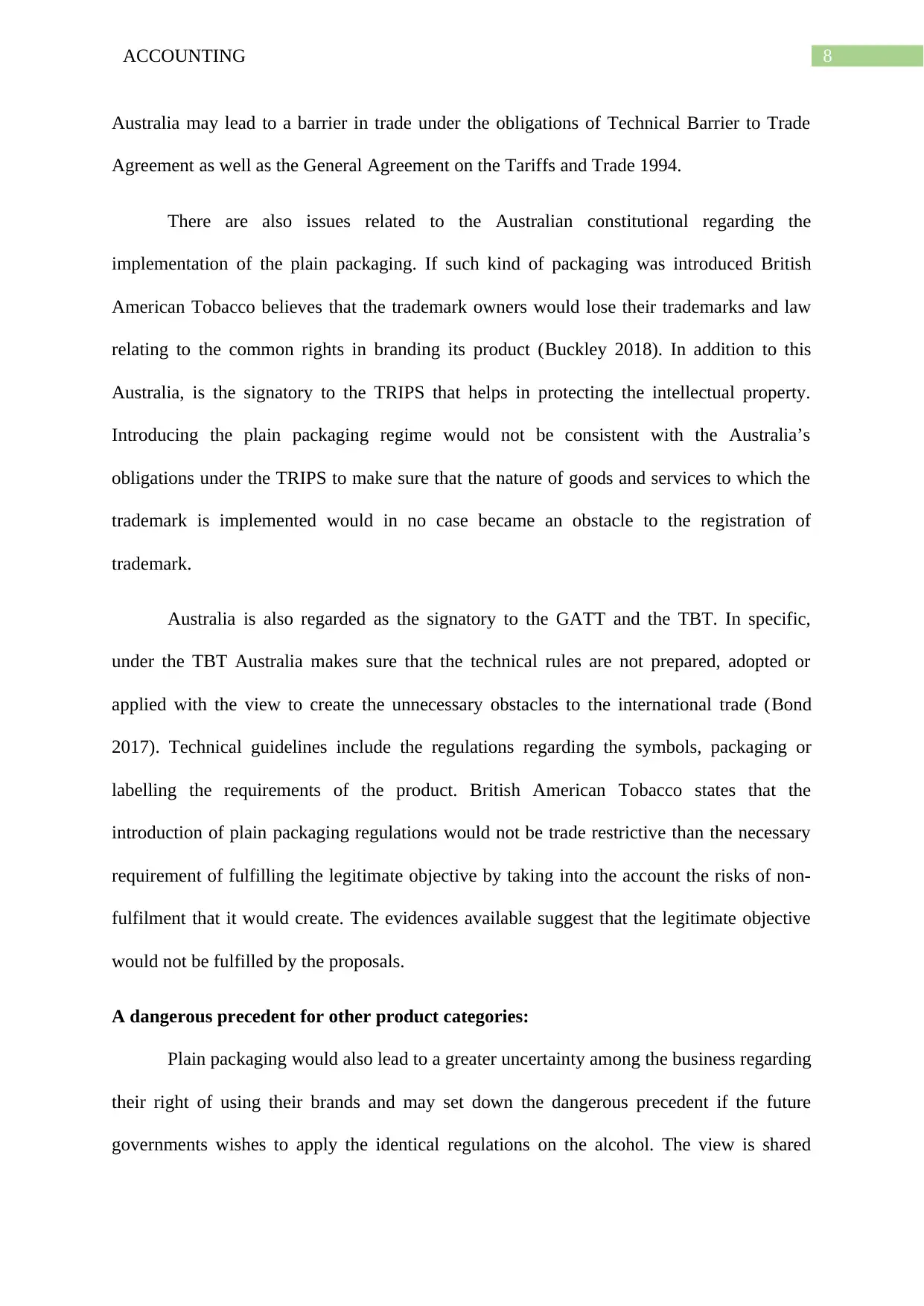
8ACCOUNTING
Australia may lead to a barrier in trade under the obligations of Technical Barrier to Trade
Agreement as well as the General Agreement on the Tariffs and Trade 1994.
There are also issues related to the Australian constitutional regarding the
implementation of the plain packaging. If such kind of packaging was introduced British
American Tobacco believes that the trademark owners would lose their trademarks and law
relating to the common rights in branding its product (Buckley 2018). In addition to this
Australia, is the signatory to the TRIPS that helps in protecting the intellectual property.
Introducing the plain packaging regime would not be consistent with the Australia’s
obligations under the TRIPS to make sure that the nature of goods and services to which the
trademark is implemented would in no case became an obstacle to the registration of
trademark.
Australia is also regarded as the signatory to the GATT and the TBT. In specific,
under the TBT Australia makes sure that the technical rules are not prepared, adopted or
applied with the view to create the unnecessary obstacles to the international trade (Bond
2017). Technical guidelines include the regulations regarding the symbols, packaging or
labelling the requirements of the product. British American Tobacco states that the
introduction of plain packaging regulations would not be trade restrictive than the necessary
requirement of fulfilling the legitimate objective by taking into the account the risks of non-
fulfilment that it would create. The evidences available suggest that the legitimate objective
would not be fulfilled by the proposals.
A dangerous precedent for other product categories:
Plain packaging would also lead to a greater uncertainty among the business regarding
their right of using their brands and may set down the dangerous precedent if the future
governments wishes to apply the identical regulations on the alcohol. The view is shared
Australia may lead to a barrier in trade under the obligations of Technical Barrier to Trade
Agreement as well as the General Agreement on the Tariffs and Trade 1994.
There are also issues related to the Australian constitutional regarding the
implementation of the plain packaging. If such kind of packaging was introduced British
American Tobacco believes that the trademark owners would lose their trademarks and law
relating to the common rights in branding its product (Buckley 2018). In addition to this
Australia, is the signatory to the TRIPS that helps in protecting the intellectual property.
Introducing the plain packaging regime would not be consistent with the Australia’s
obligations under the TRIPS to make sure that the nature of goods and services to which the
trademark is implemented would in no case became an obstacle to the registration of
trademark.
Australia is also regarded as the signatory to the GATT and the TBT. In specific,
under the TBT Australia makes sure that the technical rules are not prepared, adopted or
applied with the view to create the unnecessary obstacles to the international trade (Bond
2017). Technical guidelines include the regulations regarding the symbols, packaging or
labelling the requirements of the product. British American Tobacco states that the
introduction of plain packaging regulations would not be trade restrictive than the necessary
requirement of fulfilling the legitimate objective by taking into the account the risks of non-
fulfilment that it would create. The evidences available suggest that the legitimate objective
would not be fulfilled by the proposals.
A dangerous precedent for other product categories:
Plain packaging would also lead to a greater uncertainty among the business regarding
their right of using their brands and may set down the dangerous precedent if the future
governments wishes to apply the identical regulations on the alcohol. The view is shared
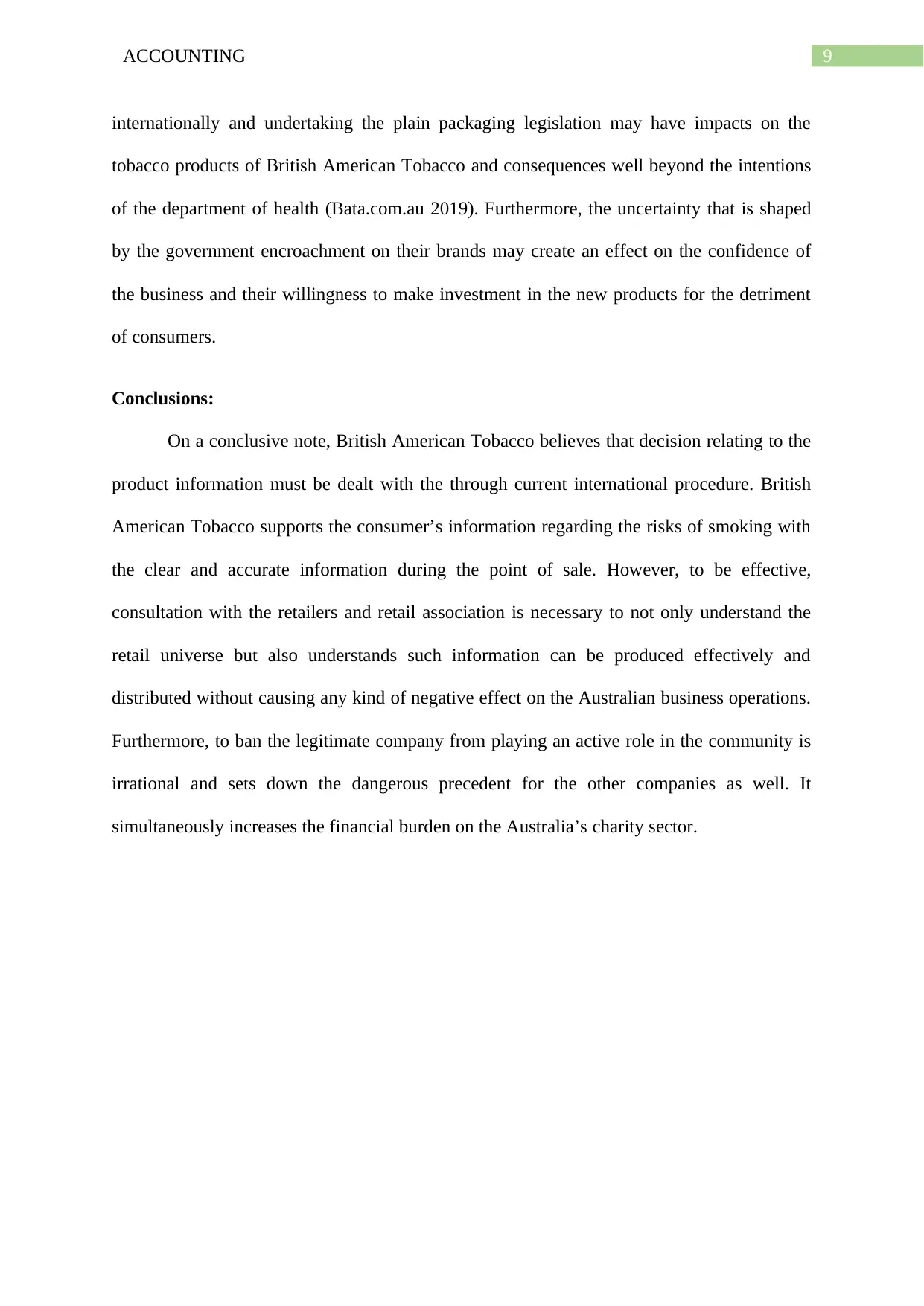
9ACCOUNTING
internationally and undertaking the plain packaging legislation may have impacts on the
tobacco products of British American Tobacco and consequences well beyond the intentions
of the department of health (Bata.com.au 2019). Furthermore, the uncertainty that is shaped
by the government encroachment on their brands may create an effect on the confidence of
the business and their willingness to make investment in the new products for the detriment
of consumers.
Conclusions:
On a conclusive note, British American Tobacco believes that decision relating to the
product information must be dealt with the through current international procedure. British
American Tobacco supports the consumer’s information regarding the risks of smoking with
the clear and accurate information during the point of sale. However, to be effective,
consultation with the retailers and retail association is necessary to not only understand the
retail universe but also understands such information can be produced effectively and
distributed without causing any kind of negative effect on the Australian business operations.
Furthermore, to ban the legitimate company from playing an active role in the community is
irrational and sets down the dangerous precedent for the other companies as well. It
simultaneously increases the financial burden on the Australia’s charity sector.
internationally and undertaking the plain packaging legislation may have impacts on the
tobacco products of British American Tobacco and consequences well beyond the intentions
of the department of health (Bata.com.au 2019). Furthermore, the uncertainty that is shaped
by the government encroachment on their brands may create an effect on the confidence of
the business and their willingness to make investment in the new products for the detriment
of consumers.
Conclusions:
On a conclusive note, British American Tobacco believes that decision relating to the
product information must be dealt with the through current international procedure. British
American Tobacco supports the consumer’s information regarding the risks of smoking with
the clear and accurate information during the point of sale. However, to be effective,
consultation with the retailers and retail association is necessary to not only understand the
retail universe but also understands such information can be produced effectively and
distributed without causing any kind of negative effect on the Australian business operations.
Furthermore, to ban the legitimate company from playing an active role in the community is
irrational and sets down the dangerous precedent for the other companies as well. It
simultaneously increases the financial burden on the Australia’s charity sector.
Secure Best Marks with AI Grader
Need help grading? Try our AI Grader for instant feedback on your assignments.
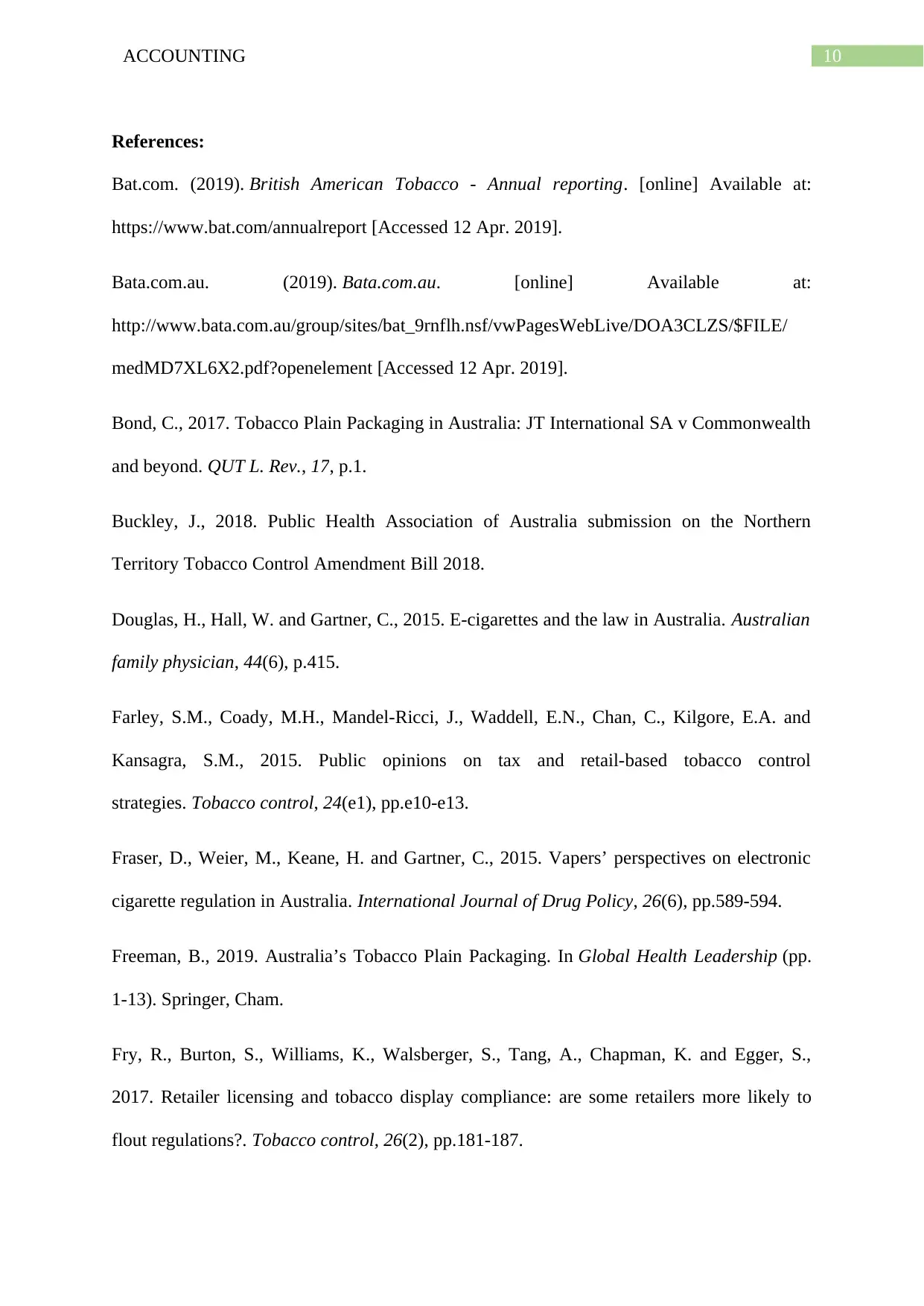
10ACCOUNTING
References:
Bat.com. (2019). British American Tobacco - Annual reporting. [online] Available at:
https://www.bat.com/annualreport [Accessed 12 Apr. 2019].
Bata.com.au. (2019). Bata.com.au. [online] Available at:
http://www.bata.com.au/group/sites/bat_9rnflh.nsf/vwPagesWebLive/DOA3CLZS/$FILE/
medMD7XL6X2.pdf?openelement [Accessed 12 Apr. 2019].
Bond, C., 2017. Tobacco Plain Packaging in Australia: JT International SA v Commonwealth
and beyond. QUT L. Rev., 17, p.1.
Buckley, J., 2018. Public Health Association of Australia submission on the Northern
Territory Tobacco Control Amendment Bill 2018.
Douglas, H., Hall, W. and Gartner, C., 2015. E-cigarettes and the law in Australia. Australian
family physician, 44(6), p.415.
Farley, S.M., Coady, M.H., Mandel-Ricci, J., Waddell, E.N., Chan, C., Kilgore, E.A. and
Kansagra, S.M., 2015. Public opinions on tax and retail-based tobacco control
strategies. Tobacco control, 24(e1), pp.e10-e13.
Fraser, D., Weier, M., Keane, H. and Gartner, C., 2015. Vapers’ perspectives on electronic
cigarette regulation in Australia. International Journal of Drug Policy, 26(6), pp.589-594.
Freeman, B., 2019. Australia’s Tobacco Plain Packaging. In Global Health Leadership (pp.
1-13). Springer, Cham.
Fry, R., Burton, S., Williams, K., Walsberger, S., Tang, A., Chapman, K. and Egger, S.,
2017. Retailer licensing and tobacco display compliance: are some retailers more likely to
flout regulations?. Tobacco control, 26(2), pp.181-187.
References:
Bat.com. (2019). British American Tobacco - Annual reporting. [online] Available at:
https://www.bat.com/annualreport [Accessed 12 Apr. 2019].
Bata.com.au. (2019). Bata.com.au. [online] Available at:
http://www.bata.com.au/group/sites/bat_9rnflh.nsf/vwPagesWebLive/DOA3CLZS/$FILE/
medMD7XL6X2.pdf?openelement [Accessed 12 Apr. 2019].
Bond, C., 2017. Tobacco Plain Packaging in Australia: JT International SA v Commonwealth
and beyond. QUT L. Rev., 17, p.1.
Buckley, J., 2018. Public Health Association of Australia submission on the Northern
Territory Tobacco Control Amendment Bill 2018.
Douglas, H., Hall, W. and Gartner, C., 2015. E-cigarettes and the law in Australia. Australian
family physician, 44(6), p.415.
Farley, S.M., Coady, M.H., Mandel-Ricci, J., Waddell, E.N., Chan, C., Kilgore, E.A. and
Kansagra, S.M., 2015. Public opinions on tax and retail-based tobacco control
strategies. Tobacco control, 24(e1), pp.e10-e13.
Fraser, D., Weier, M., Keane, H. and Gartner, C., 2015. Vapers’ perspectives on electronic
cigarette regulation in Australia. International Journal of Drug Policy, 26(6), pp.589-594.
Freeman, B., 2019. Australia’s Tobacco Plain Packaging. In Global Health Leadership (pp.
1-13). Springer, Cham.
Fry, R., Burton, S., Williams, K., Walsberger, S., Tang, A., Chapman, K. and Egger, S.,
2017. Retailer licensing and tobacco display compliance: are some retailers more likely to
flout regulations?. Tobacco control, 26(2), pp.181-187.
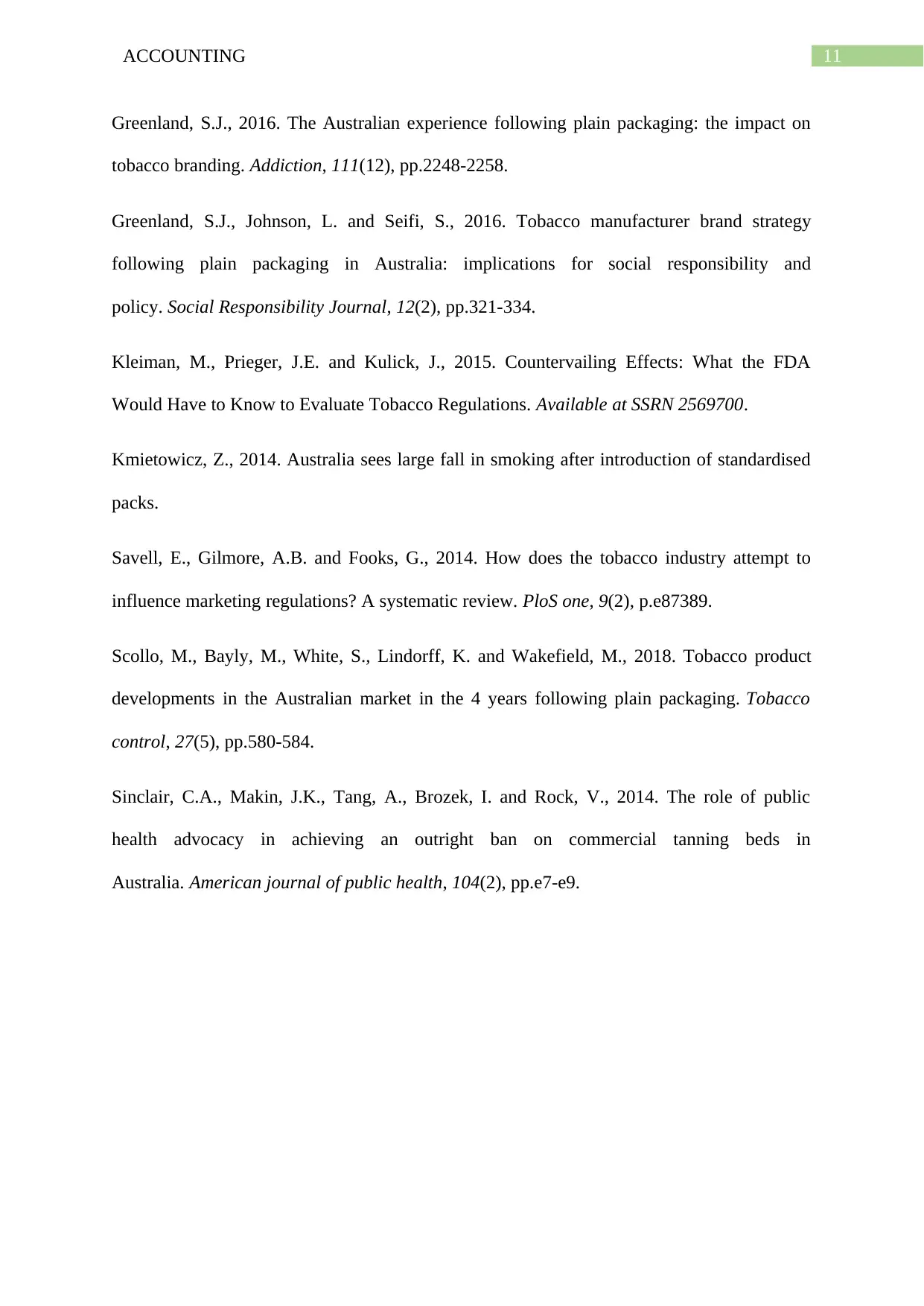
11ACCOUNTING
Greenland, S.J., 2016. The Australian experience following plain packaging: the impact on
tobacco branding. Addiction, 111(12), pp.2248-2258.
Greenland, S.J., Johnson, L. and Seifi, S., 2016. Tobacco manufacturer brand strategy
following plain packaging in Australia: implications for social responsibility and
policy. Social Responsibility Journal, 12(2), pp.321-334.
Kleiman, M., Prieger, J.E. and Kulick, J., 2015. Countervailing Effects: What the FDA
Would Have to Know to Evaluate Tobacco Regulations. Available at SSRN 2569700.
Kmietowicz, Z., 2014. Australia sees large fall in smoking after introduction of standardised
packs.
Savell, E., Gilmore, A.B. and Fooks, G., 2014. How does the tobacco industry attempt to
influence marketing regulations? A systematic review. PloS one, 9(2), p.e87389.
Scollo, M., Bayly, M., White, S., Lindorff, K. and Wakefield, M., 2018. Tobacco product
developments in the Australian market in the 4 years following plain packaging. Tobacco
control, 27(5), pp.580-584.
Sinclair, C.A., Makin, J.K., Tang, A., Brozek, I. and Rock, V., 2014. The role of public
health advocacy in achieving an outright ban on commercial tanning beds in
Australia. American journal of public health, 104(2), pp.e7-e9.
Greenland, S.J., 2016. The Australian experience following plain packaging: the impact on
tobacco branding. Addiction, 111(12), pp.2248-2258.
Greenland, S.J., Johnson, L. and Seifi, S., 2016. Tobacco manufacturer brand strategy
following plain packaging in Australia: implications for social responsibility and
policy. Social Responsibility Journal, 12(2), pp.321-334.
Kleiman, M., Prieger, J.E. and Kulick, J., 2015. Countervailing Effects: What the FDA
Would Have to Know to Evaluate Tobacco Regulations. Available at SSRN 2569700.
Kmietowicz, Z., 2014. Australia sees large fall in smoking after introduction of standardised
packs.
Savell, E., Gilmore, A.B. and Fooks, G., 2014. How does the tobacco industry attempt to
influence marketing regulations? A systematic review. PloS one, 9(2), p.e87389.
Scollo, M., Bayly, M., White, S., Lindorff, K. and Wakefield, M., 2018. Tobacco product
developments in the Australian market in the 4 years following plain packaging. Tobacco
control, 27(5), pp.580-584.
Sinclair, C.A., Makin, J.K., Tang, A., Brozek, I. and Rock, V., 2014. The role of public
health advocacy in achieving an outright ban on commercial tanning beds in
Australia. American journal of public health, 104(2), pp.e7-e9.
1 out of 12
Your All-in-One AI-Powered Toolkit for Academic Success.
+13062052269
info@desklib.com
Available 24*7 on WhatsApp / Email
![[object Object]](/_next/static/media/star-bottom.7253800d.svg)
Unlock your academic potential
© 2024 | Zucol Services PVT LTD | All rights reserved.